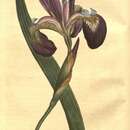en
names in breadcrumbs


Iris virginica, with the common name Virginia blueflag,[3] Virginia iris, great blue flag, or southern blue flag,[4] is a perennial species of flowering plant in the Iridaceae (iris) family, native to central and eastern North America.
It was identified as a separate species by Edgar Anderson, and is one of the three Iris species in Anderson's Iris flower data set, used by Ronald Fisher in his 1936 paper "The use of multiple measurements in taxonomic problems" as an example of linear discriminant analysis.[5][6]
Iris virginica is a perennial plant that grows up to 0.6–0.9 m (2–3 ft) tall. The plant's sword-shaped basal leaves are erect or sometimes arching and measure up to 91 cm (3 ft) long and 2.5 cm (1 in) across at the base. The leaves have smooth margins and are bluish green to green and glabrous. Unbranched or sparingly branched flowering stalks rise from the basal leaves to a height of up to 0.6–0.9 m (2–3 ft). Small, alternate leaves are located on the stalks, with 1 to 2 flowers emerging from the axil of each of these leaves on pedicels that are 3–13 cm (1–5 in) long.[7]
The flowers, which bloom May to July, are blue to blue-violet and are a typical iris shape. Each flower has 3 drooping sepals, called "falls", that have white marks and yellow near the throat, and 3 upright petals, called "standards". Flowers measure 3–13 cm (1–5 in) across.[8][9]
Iris virginica is native in the United States from Nebraska to the west, Florida and Texas to the south, New York to the east, and the Canadian border to the north. In Canada, it is native in Ontario and Quebec.[3] It grows in wet areas, sometimes in shallow water, including marshes, wet meadows, swamps, river bottoms, sloughs, ditches, bottomland prairies, edges of sinkhole ponds, and in shallow water.[10]
The Cherokee use this medicinal plant for traditional medicinal uses. The root is pounded into a paste that is used as a salve for the skin. An infusion made from the root is used to treat ailments of the liver, and a decoction of the root is used to treat "yellowish urine".[11][12]
It may be one of the Iris species used by the Seminole to treat "shock following alligator-bite".[13]
Iris virginica is one of three iris species in Ronald Fisher's Iris flower data set.
Iris virginica, with the common name Virginia blueflag, Virginia iris, great blue flag, or southern blue flag, is a perennial species of flowering plant in the Iridaceae (iris) family, native to central and eastern North America.
It was identified as a separate species by Edgar Anderson, and is one of the three Iris species in Anderson's Iris flower data set, used by Ronald Fisher in his 1936 paper "The use of multiple measurements in taxonomic problems" as an example of linear discriminant analysis.
Iris virginica, con el nombre común de iris de Virginia, es una especie perenne de planta con flores, nativa del este de América del Norte.
Es común a lo largo de la llanura costera desde Florida hasta Georgia en el sureste de los Estados Unidos.
Es una de las tres especies de Iris en el conjunto de datos de flores de iris descrito por Ronald Fisher en su artículo de 1936 "El uso de mediciones múltiples en problemas taxonómicos" como un ejemplo de análisis discriminante lineal.[1]
Iris virginica es una planta perenne. La planta tiene de 2 a 4 hojas erectas o arqueadas, de color verde brillante, en forma de lanza que se aplanan en un plano en la base. Las hojas miden 1–3 cm. De ancho y algunas veces son más largas que el tallo de la flor. Las raíces carnosas (1–2 cm) son rizomas que se propagan bajo tierra. Las semillas de color marrón pálido y de forma variable nacen en cápsulas de fruta de tres partes (3–6 cm de largo, 1–2 cm de ancho).[2]
Las flores ligeramente fragantes (4 cm de largo, 7 cm de ancho) consisten en 3 sépalos horizontales, o "caídas", y 3 pétalos erectos. Los pétalos y los sépalos pueden variar en color de violeta oscuro a blanco rosado. Los sépalos tienen un toque de amarillo a amarillo-naranja en la cresta. Cada planta tiene de 2 a 6 flores que florecen de abril a mayo en un tallo alto, erecto, de 30–90 cm de altura. El tallo a veces es ramificado y tiene un ligero aspecto en zigzag.
Los cheroqui (Cherokee) utilizan esta planta para fines de medicina tradicional. La raíz se convierte en una pasta que se utiliza como ungüento para la piel. Una infusión hecha de la raíz se usa para tratar dolencias del hígado, y una decocción de la raíz se usa para tratar la "orina de color amarillento".[3][4]
Puede ser una de las especies de iris utilizadas por la Seminole para tratar el "shock después de la mordedura de cocodrilo".
Iris virginica, con el nombre común de iris de Virginia, es una especie perenne de planta con flores, nativa del este de América del Norte.
Es común a lo largo de la llanura costera desde Florida hasta Georgia en el sureste de los Estados Unidos.
Es una de las tres especies de Iris en el conjunto de datos de flores de iris descrito por Ronald Fisher en su artículo de 1936 "El uso de mediciones múltiples en problemas taxonómicos" como un ejemplo de análisis discriminante lineal.
Iris virginica là một loài thực vật có hoa trong họ Diên vĩ. Loài này được Carl von Linné miêu tả khoa học đầu tiên năm 1753.[1]
Iris virginica là một loài thực vật có hoa trong họ Diên vĩ. Loài này được Carl von Linné miêu tả khoa học đầu tiên năm 1753.